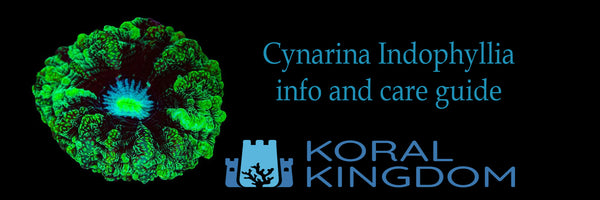Cynarina Indophyllia, also known as the meat coral or doughnut coral, is a popular species of LPS (Large Polyp Stony) coral found in reef aquariums. Its vibrant color, unique texture, and ease of care make it a great addition to any reef tank.
Appearance:
Cynarina Indophyllia is a large, circular coral with a fleshy appearance. Its surface is covered in lumpy bumps that give it a meaty texture. Its coloration can range from shades of green, yellow, blue, and brown, and it may also have bright neon center eyes.

Habitat:
Cynarina Indophyllia is a native to the Indo-Pacific, including the Red Sea, and can be found in shallow waters. In nature, it thrives on both hard and soft substrates, and its ability to adapt to a wide range of conditions allows it to be an adaptable coral in the home aquarium.
Lighting and Water Parameters:
Cynarina Indophyllia prefers moderate to high light levels, but care must be taken not to blast it with too much direct sunlight. Similarly, water flow should be moderate and not too strong, as it can damage the delicate tissue of the coral. pH levels should be between 8.0-8.4, with temperature between 76-82°F.
Feeding:
Cynarina Indophyllia is a mixotrophic coral, meaning it can feed both through photosynthesis and by consuming small prey. In the wild, it feeds on zooplankton and other small organisms, and in the home aquarium, it can be fed small bits of fresh or prepared meaty foods, including fish, scallops, and mysis shrimp. Here at Koralkingdom we feed them sinking fish pellet food.
Care:
Cynarina Indophyllia is a hardy and easy-to-care-for species. It is not aggressive towards other corals, making it an ideal choice for a mixed reef tank. However, care should be taken not to place it too close to other corals, as it can sting them with its sweeper tentacles.
In conclusion, Cynarina Indophyllia is a unique and stunning coral that can bring a bold pop of color and texture to a reef aquarium. With proper care and feeding, this LPS coral can thrive and grow in a home aquarium for years to come.
Acclimating Corals And Dipping Corals
- Turn off aquarium lights: Acclimating corals is a stressful process for them, and turning off the aquarium lights can reduce their stress levels.
- Float the bag: Once you receive your corals, float the bag in the aquarium for around 5-10 minutes. Ensure the water temperature in the bag matches the aquarium temperature before proceeding.
- Slowly drip water: After floating for 20 minutes, empty the contents of the bag into a bucket or container filled with aquarium water. Then, take a small airline tubing and drip the aquarium water into the container every few seconds. This allows the coral to slowly acclimate to the new water conditions.
- Mix a coral dip: In a separate container, mix a coral dip according to the package instructions. The dip will usually contain ingredients like iodine, potassium, and other antiseptics that will kill unwanted pests.
- agitate the water for around 5 to 10 minutes.
- Rinse the coral: After the dipping process, rinse the coral in a separate container filled with aquarium water to ensure all the dip has been removed.
- Place the coral: After the drip acclimation process is complete, you are now ready to place the coral into the aquarium.
In conclusion, acclimation and dipping of all your new corals are a crucial step in successfully adding them to your aquarium. Proper acclimation and dipping can prevent the introduction of harmful pests and diseases to your tank, ensuring the continued growth and health of your corals. Follow the above guided steps to make sure your corals adapt well to your aquarium.
keeping and maintaining Euphyllia corals long term
Keeping corals healthy in an aquarium requires more than just a beautiful display. It involves careful consideration of water quality, lighting, and food sources. A crucial factor in maintaining long-term coral health is providing a stable and consistent environment.
One of the most important steps in maintaining good coral health is regular water quality testing. Water parameters such as temperature, pH, ammonia, nitrite, and nitrate should be tested regularly, and adjustments should be made as needed. Investing in a quality skimmer can also help to remove excess nutrients and improve water quality.
Another crucial factor in maintaining coral health is proper lighting. Corals rely on light for photosynthesis, which means they need a balanced spectrum of light to thrive. A lighting system that provides both blue and white light can help to create an ideal environment for coral growth. Additionally, it's important to consider light intensity and duration to prevent overexposure. Koralkingdom uses the Mobius app for their templates for lighting. It can work for AI and Radion products and we highly recommend you try it.
Feeding corals can also play a role in their long-term health. While some corals can survive on photosynthesis alone, many require additional food sources. Feeding your corals a varied diet of small, nutrient-rich foods, such as zooplankton, can help to keep them healthy and promote growth. Reef roids and other small particle foods are great. We first dissolve the food into a cup of aquarium water then pour it in front of a power head to disperse the food to the corals. Turning off the Sump pump for about 15 minutes would help the food not get filtered out delivering more food to your corals.
Proper husbandry practices can also help to prevent common coral diseases or pests. Quarantining new additions to the aquarium and maintaining good water quality can help to prevent the spread of diseases, while proper cleaning practices can help to remove unwanted algae or pests.
In summary, maintaining long-term coral health in an aquarium requires careful consideration of water quality, lighting, and feeding practices. By providing stable and consistent environments, corals can thrive, adding to the beauty and diversity of your aquarium.
For more blogs and guides visit Koralkingdom!


